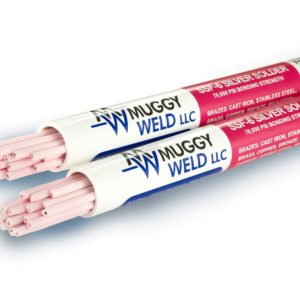How to TIG Weld Cast Iron with Muggy Weld 77 electrode–Another video from Brandon Lund’s YouTube channel.
In this video, Brandon demonstrates 2 different TIG repairs with 77 cast iron welding rods: First, he TIG welds a cast iron handle that’s completely broken off. Next, uses a TIG machine to weld a large hole in the cast iron skillet that extends into a long crack.
“Cast iron can be tricky to TIG repair because it’s prone to cracking. Follow along as I repair a broken cast iron skillet handle using specialty welding rods with TIG. I also show you 5 ways to determine if your part is cast iron or cast steel. This TIG weld repair method uses a preheat and a cool down. For this repair I used Muggy Weld #77 welding electrodes for it’s excellent crack resistance properties. After the TIG repair was made, I wanted to see just how strong a piece of welded cast iron really is, so I clamped the handle to the workbench and began stacking weight on the skillet until eventually the weld failed! Wait until you see the results! This is just a demonstration. Nickel is a carcinogen. I would not weld anything with nickel that you ingest. I chose to weld this skillet to eliminate any accusations that this is made from anything other than cast iron.”
5 methods to determine if your part is cast iron or cast steel:
1. The simplest method is to check to see if the part says cast iron. Cast steel is brighter than cast iron and has small bubble-like depressions.
2. If the part is broken, look at the grain structure. Brandon shows examples of both cast iron and cast steel grain structure, enabling the viewer to visually identify the difference. Cast iron usually show evidences of the sand mold, cast steel shows forging or rolling marks.
3. Spark test. Grind the part and watch the color and shape of the spark. Cast iron: the color tends to be the brightest at the end of the spark and the spark lines are long and fade out with cooling. Cast steel the color turns bright orange-ish right at the grinding wheel and have short lines and many explosions.
4. Drill it. Again, Brandon shows examples of both cast iron and cast steel when drilled, demonstrating the difference visually. Cast iron tends to create graphite-like dust, whereas cast steel creates bright and shiny curl-q metal shavings.
5. File test. Run a file over the edge of your metal as shown.
Thank you, Brandon for allowing Muggy Weld to feature your video on our site. Please subscribe to Brandon’s channel using the following link:
Note: Please observe all AWS Safety & Health Guidelines when using Muggy Weld products.
Check Out These Products
-

Silver Solder Rod: Flux-Coated SSF-6 56% Brazing Rod
$69.00 – $260.00High-Strength, 56% Silver Solder Rod🌡 Melting Temperature 1150 / 621 ⇄︎ Bonding Strength 70000 psi, 482.63 MPa 🔧︎ Sizes Available (in) 1/16 🔧︎ Sizes Available (mm) 1.58 -

Super Alloy 5 Aluminum Welding and Brazing Rod
$69.00 – $109.00600°F aluminum welding, brazing, and soldering rod. Ideal for aluminum boat repair and cast aluminum.🌡 Melting Temperature 600 / 317 ⇄︎ Bonding Strength 30000 psi, 206.84 MPa

